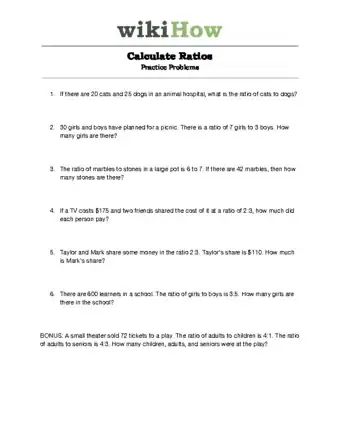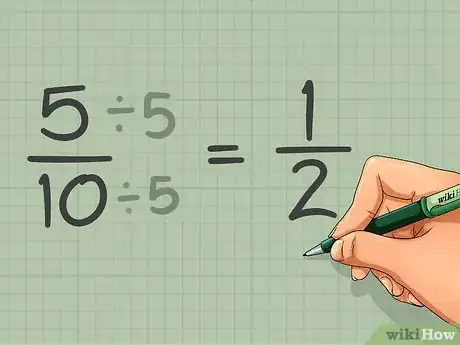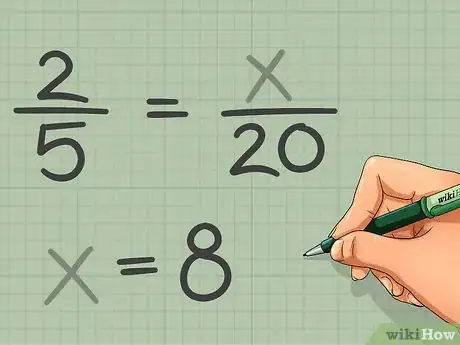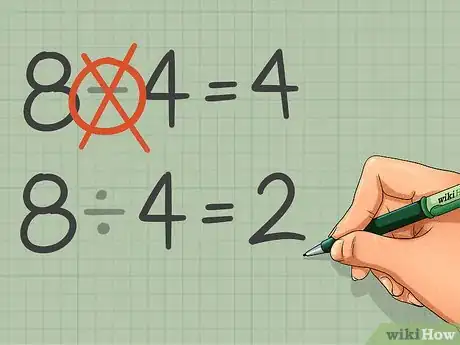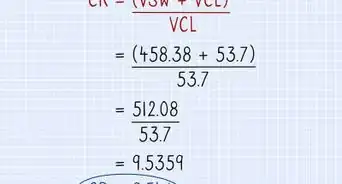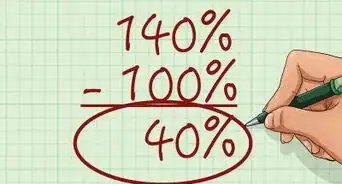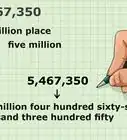This article was co-authored by Grace Imson, MA. Grace Imson is a math teacher with over 40 years of teaching experience. Grace is currently a math instructor at the City College of San Francisco and was previously in the Math Department at Saint Louis University. She has taught math at the elementary, middle, high school, and college levels. She has an MA in Education, specializing in Administration and Supervision from Saint Louis University.
This article has been viewed 2,956,662 times.
Ratios are mathematical expressions that compare two or more numbers. They can compare absolute quantities and amounts or can be used to compare portions of a larger whole. Ratios can be calculated and written in several different ways, but the principles guiding the use of ratios are universal to all.
Steps
Understanding Ratios
-
1Be aware of how ratios are used. Ratios are used in both academic settings and in the real world to compare multiple amounts or quantities to each other. The simplest ratios compare only two values, but ratios comparing three or more values are also possible. In any situations in which two or more distinct numbers or quantities are being compared, ratios are applicable. By describing quantities in relation to each other, they explain how chemical formulas can be duplicated or recipes in the kitchen expanded. After you get to understand them, you will use ratios for the rest of your life.[1]
-
2Get to know what a ratio means. As noted above, ratios demonstrate the quantity of at least two items in relation to each other. So, for example, if a cake contains two cups of flour and one cup of sugar, you would say that the ratio of flour to sugar was 2 to 1.
- Ratios can be used to show the relation between any quantities, even if one is not directly tied to the other (as they would be in a recipe). For example, if there are five girls and ten boys in a class, the ratio of girls to boys is 5 to 10. Neither quantity is dependent on or tied to the other, and would change if anyone left or new students came in. The ratio merely compares the quantities.
Advertisement -
3Notice the different ways in which ratios are expressed. Ratios can be written out using words or can be represented using mathematical symbols.[2]
- You will commonly see ratios represented using words (as above). Because they are used so commonly and in such a variety of ways, if you find yourself working outside of mathematic or scientific fields, this may the most common form of ratio you will see.
- Ratios are frequently expressed using a colon. When comparing two numbers in a ratio, you'll use one colon (as in 7 : 13). When you're comparing more than two numbers, you'll put a colon between each set of numbers in succession (as in 10 : 2 : 23). In our classroom example, we might compare the number of boys to the number of girls with the ratio 5 girls : 10 boys. We can simply express the ratio as 5 : 10.
- Ratios are also sometimes expressed using fractional notation. In the case of the classroom, the 5 girls and 10 boys would be shown simply as 5/10. That said, it shouldn't be read out loud the same as a fraction, and you need to keep in mind that the numbers do not represent a portion of a whole.
Using Ratios
-
1Reduce a ratio to its simplest form. Ratios can be reduced and simplified like fractions by removing any common factors of the terms in the ratio. To reduce a ratio, divide all the terms in the ratio by the common factors they share until no common factor exists. However, when doing this, it's important not to lose sight of the original quantities that led to the ratio in the first place.[3]
- In the classroom example above, 5 girls to 10 boys (5 : 10), both sides of the ratio have a factor of 5. Divide both sides by 5 (the greatest common factor) to get 1 girl to 2 boys (or 1 : 2). However, we should keep the original quantities in mind, even when using this reduced ratio. There are not 3 total students in the class, but 15. The reduced ratio just compares the relationship between the number of boys and girls. There are 2 boys for every girl, not exactly 2 boys and 1 girl.
- Some ratios cannot be reduced. For example, 3 : 56 cannot be reduced because the two numbers share no common factors - 3 is a prime number, and 56 is not divisible by 3.
-
2Use multiplication or division to "scale" ratios. One common type of problem that employs ratios may involve using ratios to scale up or down the two numbers in proportion to each other. Multiplying or dividing all terms in a ratio by the same number creates a ratio with the same proportions as the original, so, to scale your ratio, multiply or divide through the ratio by the scaling factor.[4]
- For example, a baker needs to triple the size of a cake recipe. If the normal ratio of flour to sugar is 2 to 1 (2 : 1), then both numbers must be increased by a factor of three. The appropriate quantities for the recipe are now 6 cups of flour to 3 cups of sugar (6 : 3).
- The same process can be reversed. If the baker needed only one-half of the normal recipe, both quantities could be multiplied by 1/2 (or divided by two). The result would be 1 cup of flour to 1/2 (0.5) cup of sugar.
-
3Find unknown variables when given two equivalent ratios. Another common type of problem that incorporates ratios asks you to find an unknown variable in one ratio, given the other number in that ratio and a second ratio that is equivalent to the first. The principle of cross multiplication makes solving these problems fairly simple. Write each ratio in its fractional form, then set the two ratios equal to each other and cross multiply to solve.[5]
- For example, let's say we have a small group of students containing 2 boys and 5 girls. If we were to maintain this proportion of boys to girls, how many boys would be in a class that contained 20 girls? To solve, first, let's make two ratios, one with our unknown variables: 2 boys : 5 girls = x boys : 20 girls. If we convert these ratios to their fraction forms, we get 2/5 and x/20. If you cross multiply, you are left with 5x=40, and you can solve by dividing both figures by 5. The final solution is x=8.
EXPERT TIPGrace Imson is a math teacher with over 40 years of teaching experience. Grace is currently a math instructor at the City College of San Francisco and was previously in the Math Department at Saint Louis University. She has taught math at the elementary, middle, high school, and college levels. She has an MA in Education, specializing in Administration and Supervision from Saint Louis University.Math Instructor, City College of San Francisco
 Grace Imson, MA
Grace Imson, MA
Math Instructor, City College of San FranciscoLook at the order of terms to figure out the numerator and denominator in a word problem. The first term is usually the numerator, and the second is usually the denominator. For example, if a problem asks for the ratio of the length of an item to its width, the length will be the numerator, and width will be the denominator.
Catching Mistakes
-
1Avoid addition or subtraction in ratio word problems. Many word problems look something like this: "A recipe calls for 4 potatoes and 5 carrots. If you want to use 8 potatoes instead, how many carrots will you need to keep the ratio the same?" Many students try to add the same amount of each quantity. You actually need to use multiplication, not addition, to keep the ratio the same. Here's an example of the wrong and right to solve this example:
- Wrong method: "8 - 4 = 4, so I added 4 potatoes to the recipe. That means I should take the 5 carrots and add 4 to that too... wait! That's not how ratios work. I'll try again."
- Right method: "8 ÷ 4 = 2, so I multiplied the number of potatoes by 2. That means I should multiply the 5 carrots by 2 as well. 5 x 2 = 10, so I want 10 carrots total in the new recipe."
-
2Convert to the same units. Some word problems get tricky by switching to a different unit partway through. Convert to the same unit before finding the ratio. Here's an example problem and solution:
- A dragon has 500 grams of gold and 10 kilograms of silver. What is the ratio of gold to silver in the dragon's hoard?
- Grams and kilograms are not the same unit, so we'll need to convert. 1 kilogram = 1,000 grams, so 10 kilograms = 10 kilograms x = 10 x 1,000 grams = 10,000 grams.
- The dragon has 500 grams of gold and 10,000 grams of silver.
- The ratio of gold to silver is .
-
3Write your units in the problem. In ratio word problems, it's much easier to catch mistakes if you write the units after each value. Remember, the same unit on the top and bottom of a fraction cancels out. After you cancel out as much as you can, you should end up with the right units for your answer.
- Example problem: If you have six boxes, and in every three boxes there are nine marbles, how many marbles do you have?
- Wrong method: Wait, nothing cancels out, so my answer would be "boxes x boxes / marbles." That doesn't make sense.
- Right method:
18 marbles.
EXPERT TIPGrace Imson is a math teacher with over 40 years of teaching experience. Grace is currently a math instructor at the City College of San Francisco and was previously in the Math Department at Saint Louis University. She has taught math at the elementary, middle, high school, and college levels. She has an MA in Education, specializing in Administration and Supervision from Saint Louis University.Math Instructor, City College of San Francisco
 Grace Imson, MA
Grace Imson, MA
Math Instructor, City College of San FranciscoOne common problem is knowing which number to use as a numerator. In a word problem, the first term stated is usually the numerator and the second term stated is usually the denominator. If you want the ratio of the length of an item to the width, length becomes your numerator and width becomes your denominator.
Community Q&A
-
QuestionHow do you calculate if something cost $175, and two people shared the cost at a ratio of 2:3?
 Community Answer1. You add the numbers of the ratio: 2 + 3 = 5 2. You divide the total cost ($175) by 5. 175 / 5 = 35 3. You multiply this number by each of the numbers of the ratio: 35 x 2 = 70, and 35 x 3 = 105. Solution: one paid $70, and the other one, $105. Both numbers added give you the total of 175 dollars.
Community Answer1. You add the numbers of the ratio: 2 + 3 = 5 2. You divide the total cost ($175) by 5. 175 / 5 = 35 3. You multiply this number by each of the numbers of the ratio: 35 x 2 = 70, and 35 x 3 = 105. Solution: one paid $70, and the other one, $105. Both numbers added give you the total of 175 dollars. -
QuestionA small theater sold 72 tickets to a play. The ratio of adults to children is 4:1. The ratio of adults to seniors is 4:3. How do I determine how much of each were sold?
 DonaganTop AnswererThe ratio of adults to seniors to children is 4:3:1. Add those three numbers, and divide the sum into 72. Multiply the quotient by 4, 3, and 1 to find the number sold of each kind of ticket.
DonaganTop AnswererThe ratio of adults to seniors to children is 4:3:1. Add those three numbers, and divide the sum into 72. Multiply the quotient by 4, 3, and 1 to find the number sold of each kind of ticket. -
QuestionHow do you convert the ratio 1:4 to a decimal or a percent?
 Community AnswerYou can treat a ratio as a fraction or a division problem: 1:4 = 1 / 4 = 1 ÷ 4. Solve this problem with long division (or a calculator) and you'll get the answer as a decimal: 0.25. To make this a percent, just move the decimal point two spaces to the right: 0.25 = 25%.
Community AnswerYou can treat a ratio as a fraction or a division problem: 1:4 = 1 / 4 = 1 ÷ 4. Solve this problem with long division (or a calculator) and you'll get the answer as a decimal: 0.25. To make this a percent, just move the decimal point two spaces to the right: 0.25 = 25%.
References
- ↑ http://www.virtualnerd.com/common-core/grade-6/6_RP-ratios-proportional-relationships/A
- ↑ http://www.purplemath.com/modules/ratio.htm
- ↑ http://www.helpwithfractions.com/math-homework-helper/least-common-denominator/
- ↑ http://www.mathplanet.com/education/algebra-1/how-to-solve-linear-equations/ratios-and-proportions-and-how-to-solve-them
- ↑ http://www.math.com/school/subject1/lessons/S1U2L2DP.html
About This Article
To calculate a ratio, start by determining which 2 quantities are being compared to each other. For example, if you wanted to know the ratio of girls to boys in a class where there are 5 girls and 10 boys, 5 and 10 would be the quantities you're comparing. Then, put a colon or the word "to" between the numbers to express them as a ratio. In this example, you'd write "5 to 10" or "5:10." Finally, simplify the ratio if possible by dividing both numbers by the greatest common factor. To learn how to solve equations and word problems with ratios, scroll down!
